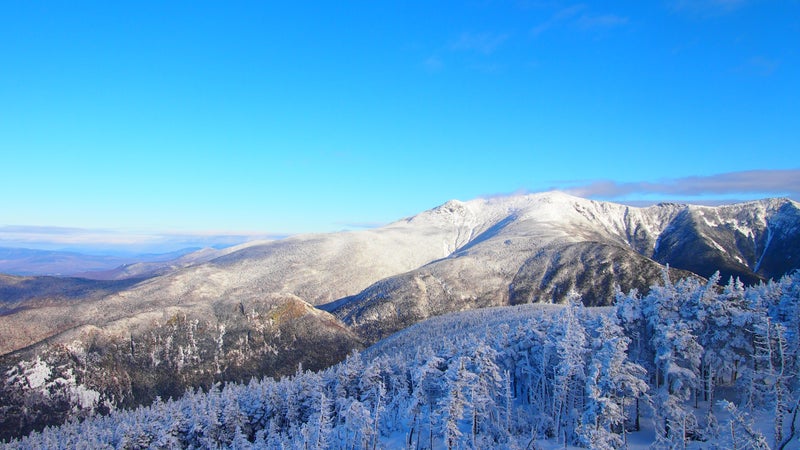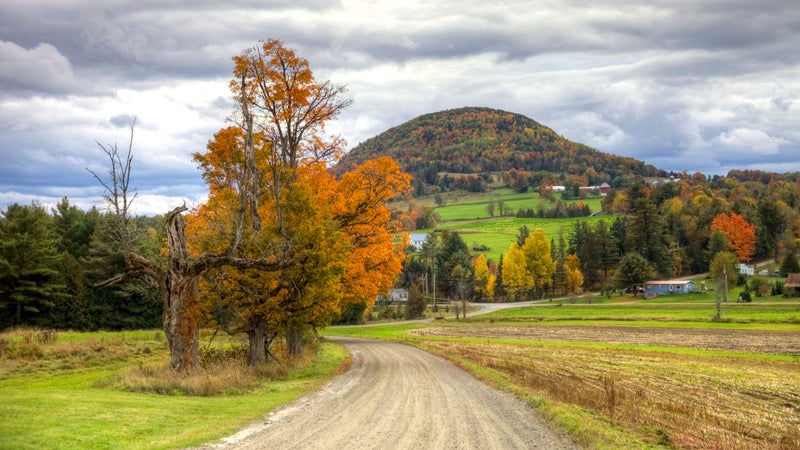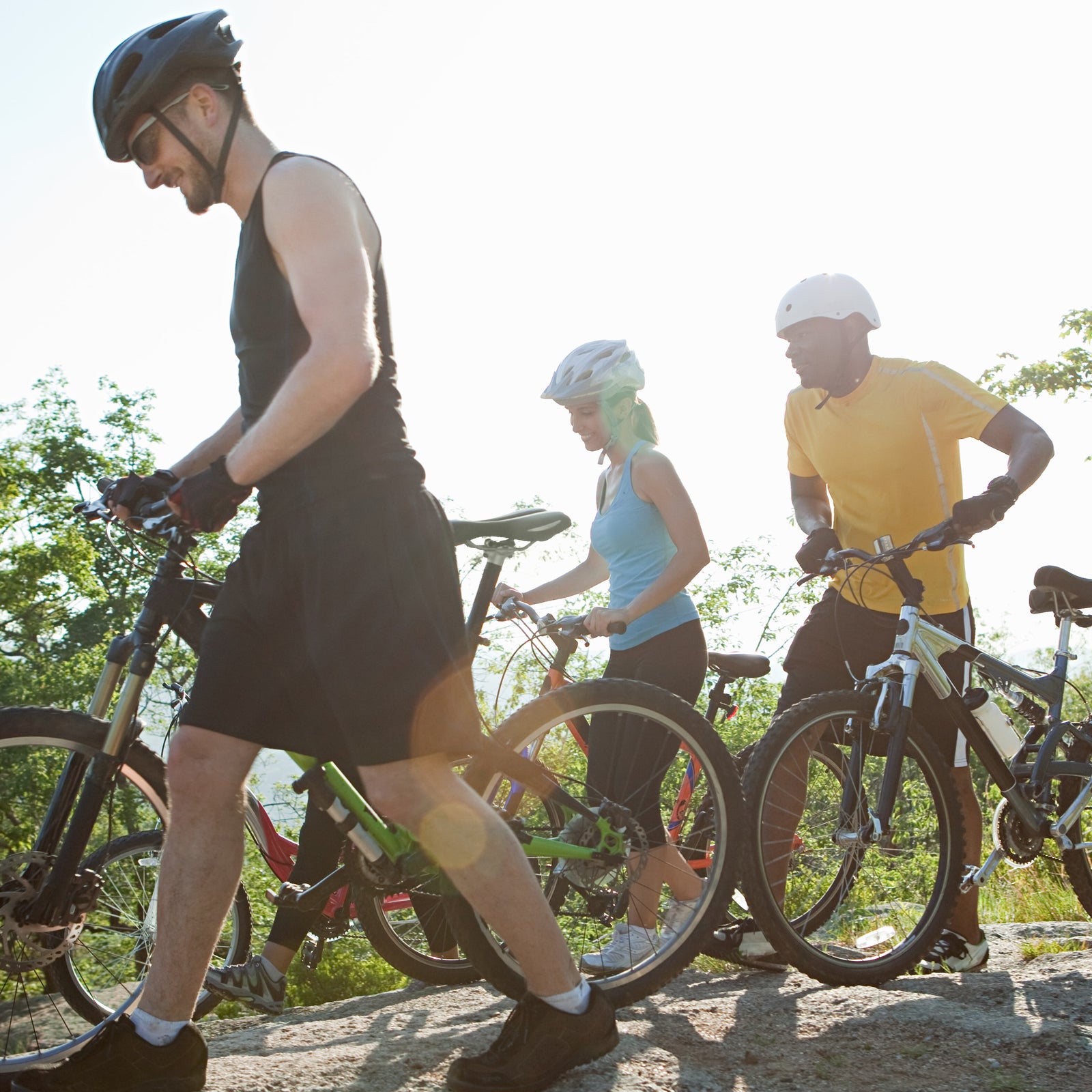On a weekday morning in╠řJanuary╠řin New HampshireÔÇÖs ,╠řthe base of the gladed backcountry ski zone╠řcould have been mistaken for a Walmart parking lot on Black Friday. Some skiers sat anxiously in their cars, waiting for a spot to open up, while others parked at the nearby ╠řand walked the mile up the road╠řwith their skis slung over their shoulders. After a slow start to the season in New England, there was finally enough snowpack╠řto abandon the groomers for backcountry terrain.
It wasnÔÇÖt always like this. Unlike the West, backcountry╠řskiing on the East Coast╠řhas distinct challenges. The amount of private property in the region is staggeringÔÇöonly 4╠řpercent of land╠řeast of Mississippi is public, compared with╠ř47 percent in╠řthe WestÔÇöand access to it╠řis hindered by a complex web of private landowners, trusts, and federal and public managers, not to mention dense╠řnew-growth forests. ÔÇťHistorically, because of the East CoastÔÇÖs tree-density issues, backcountry skiers would either venture to natural alpine areas or were commonly found cutting unapproved lines,ÔÇŁ said Tyler Ray, founder of the╠ř╠ř(│ĎÁ■┤í),╠řa nonprofit organization based in North Conway, New Hampshire, with nearly a thousand members that advocates for increased access to the sport. ÔÇťYou would often see╠řthese egregious cuts in the forest, and╠řin some cases, people had to serve jail╠řtime. WeÔÇÖve been able to bridge the gap of opening access to new terrain and educating skiers.ÔÇŁ
But╠řstarting in 2016, Maple Villa and a handful of other╠řglades in the vicinityÔÇöincluding ╠řin EvanÔÇÖs Notch, on the MaineÔÇôNew Hampshire state line, and , part of╠řthe 10,000-acre ÔÇöhave been among the few╠řskiable backcountry zones╠řin a region where theyÔÇÖre╠řincredibly limited. These areas of the White Mountains are╠řa result of five years of advocacy and planning work by the GBA. Prior to their development, out-of-bounds skiing was only possible in above-tree-line terrain, a few natural drainages and old avalanche paths, and a handful of former╠řski trails built by the Civilian Conservation Corps nearly a century╠řago. Since launching five years ago, the GBA has been working with landowners and land managers to obtain approval for public access and to create gladed ski areas, adding significant acreage to the few less-developed local ski spots, like the ╠řand ski trails, that existed prior to its inception.
To secure these sites, GBA members spend countless hours building relationships and trust with landowners and managers, educating them on the benefits these zones will have on their╠řcommunities and addressing their concerns. Once access is approved, the U.S. Forest Service collaborates with the GBA on what trees should and shouldnÔÇÖt be cut, how to minimize the risk of erosion, and other above-ground vegetation management measures that ensure any cutting is being done in a sustainable way. The organization then hosts ÔÇťglade days,ÔÇŁ╠řwhere up to 75 volunteers come out to help cut the outdoor space╠řtheyÔÇÖll eventually end up skiing. In five years, the group╠řhas successfully built eight glades in New Hampshire and western Maine, for a cumulative total of╠ř8,100 vertical feet of skiable terrain, and more are in the works, potentially in the Pemigewasset and Androscoggin districts of White Mountain National Forest.

Rural communities, like╠řthose near the GBAÔÇÖs glades, benefit greatly from the development of outdoor recreational venues, a fact that can easily convince private landowners to sign on. A recent economic analysis of Maple Villa, Crescent Ridge, and Baldface revealed that nearly $1 million in revenue was generated within the local community during the 2018ÔÇô19 ski season alone, according to Ray.
The main concern for most landowners, Ray says, is liability. But in New Hampshire and Maine, protect landowners who allow people to recreate on their property. In New Hampshire, these╠řlaws ensure that landowners wonÔÇÖt be held accountable for any injuries or damages that occur on their land, provided they donÔÇÖt charge visitors a fee for access and donÔÇÖt do anything obviously negligent that results in injury, such as suddenly building a fence across an already established ski zone without proper╠řsignage.
Maine has similar protection laws, but landowners╠řare permitted to charge fees for recreational use. It is understood that users of these zones are doing so at their own risk, and that they will be held responsible if they are injured while on someoneÔÇÖs property. If that does occur, local and state organizations, like the , are typically notified by the injured party or another person who is around to help.
While the GBA is the newest organization of this kind, it isnÔÇÖt╠řthe first one working to expand opportunities for recreation on the East Coast. In Vermont, the (RASTA) was founded after Hurricane IreneÔÇÖs devastating toll on small communities in 2013. ÔÇťIt was really a way to rebuild these communities that were hit by this storm,ÔÇŁ said Zac Freeman, a founding member of the alliance. ÔÇťWe hoped it would give folks something to look forward to and would help some of the struggling businesses. But at the core of it, weÔÇÖre doing it because we want to create more opportunities to recreate in these small towns.ÔÇŁ
RASTA helped grow VermontÔÇÖs backcountry ski network significantly. Along with liaising with private landowners, it╠řalso worked with the Forest Service to create the ╠řin 2017, one of the first actively managed backcountry ski zones on Forest Service╠řland in the country. The╠řproject╠řinitially encompassed╠řfour separate areas, but today╠řit offers more than 28,000 combined vertical feet across six separate gladed zones around╠řthe state, all╠řmanaged by RASTA.
Before the GBA or RASTA, there was the . Founded in 1994 in East Burke, Vermont, the KTA╠řwas one of the first organizations to begin working with private landowners to create outdoor access. After 25 years, it had secured a network of more than 100 miles of cross-country and downhill trails╠řand is now considered one of New EnglandÔÇÖs premier╠řsingletrack mountain-biking destinations. These arrangements between the association and the more than╠ř100 private landowners currently signed on were based╠řprimarily on╠řthe promise that the trails would benefit the communityÔÇölandowners receive no financial compensation for allowing public access. Fulfilling that promise, it is estimated that the for the surrounding communities╠řduring the 2019 fiscal year.

But these contracts, which rely on trust, are nonbinding, and landowners always have the option to revoke their access. In fact, in December 2019, a few landowners informed the KTA that they would no longer permit mountain bikers on their property (although they did continue to allow other forms of recreation, like snowshoeing and trail running), resulting in the loss of nearly 12 miles of trails to cyclists. While the landowners havenÔÇÖt publicly stated their reasoning╠řand couldnÔÇÖt be reached for comment, the association speculated that they╠řfelt their land wasnÔÇÖt being respected by mountain bikers, a concern that may have been amplified by an extreme increase in trail use in recent years.
Elise Lawson, a KTA╠řlandowner╠řwith property just north of those who revoked access, and a member of the KTAÔÇÖs board of directors, has noticed an increase in users and trail congestion since purchasing her╠řproperty in 2003. And while her experience with mountain bikers has been overwhelmingly positive, she did note that there are occasional exceptions.
ÔÇťI feel that some people who come might not be aware that Kingdom Trails is composed of private landowners,ÔÇŁ said Lawson. ÔÇťI think some people may have been getting a sense of entitlement rather than gratitude.ÔÇŁ
For the KTA, the landownersÔÇÖ decision served as a wake-up call.
ÔÇťWe recognize that we should have been more effectively communicating with our landowners,ÔÇŁ said Abby Long, Kingdom TrailsÔÇÖ executive director. ÔÇťBut we also needed to be educating our trail users on proper etiquette.ÔÇŁ
To keep this from happening again, the organization╠řhas been soliciting ideas and feedback from landowners and community members. It has also been investing in research and communication through a USDA-funded that addresses and promotes sustainable growth and╠řa new advisory committee that allows landowners to become╠řmore involved in planning, as well as╠řuser engagement and education through an expanded ambassador program╠řand╠ř campaign, which is a code of ethics directed at the mountain-biking community that was╠řcreated by the Northern Forest CenterÔÇÖs .
ÔÇťItÔÇÖs our responsibility to ensure that we protect the privilege to recreate on private lands,ÔÇŁ said RASTAÔÇÖs Freeman. ÔÇťBecause it isnÔÇÖt a right. And itÔÇÖs our job, as GBA, RASTA, and the New England Mountain Bike Association, to promote responsibility, trail ethics, and landowner stewardship.ÔÇŁ
In late January, RASTA dealt with a similar issue. A police report filed by a skier╠řon January 25 stated that two gunshots were heard after the skier╠řaccidentally crossed onto an abutting╠řproperty, followed by a third approximately 15╠řminutes later. The organization was notified, and it immediately closed the trail network in an attempt to resolve the issue. RASTA couldnÔÇÖt confirm the source of the shots, but as a precaution, volunteers helped reroute the trail farther away from the property and add signage to create a quiet zone. The trail reopened a few weeks later╠řand hasnÔÇÖt seen any incidents since.
ÔÇťItÔÇÖs our responsibility to ensure that we protect the privilege to recreate on private lands,ÔÇŁ said RASTAÔÇÖs Freeman. ÔÇťBecause it isnÔÇÖt a right. And itÔÇÖs our job, as GBA, RASTA, and the New England Mountain Bike Association, to promote responsibility, trail ethics, and landowner stewardship.ÔÇŁ
To help educate its users, the GBA, in collaboration with , a national nonprofit representing backcountry skiers on public lands, recently introduced , a code of conduct that they will share at their sites moving forward, which involves simple yet effective measures such as respecting closures and packing out garbage.
In a similar effort, over a thousand╠řbusinesses, organizations, and influential individuals formed the╠ř╠řlast fall, which was born during an uptick in general outdoor recreation during COVID-19 to promote responsible ways to get outside.
Despite the challenges and hurdles to create and bolster╠řthese recreational spaces╠řin the Northeast, the GBAÔÇÖs Ray is optimistic. ÔÇťThis outdoor economy is taking over,ÔÇŁ he said. ÔÇťAnd these organizations╠řare showing that it can be sustainable and support small towns. ItÔÇÖs really a way of life.ÔÇŁ
While the organizations have largely been successful, their continued growth depends on the respect and awareness of the visitors who recreate on these lands. ÔÇťI feel that every trail user represents the organization,ÔÇŁ said Freeman. ÔÇťBecause you never know who youÔÇÖre gonna pass on the trail. It could be the landowner that allowed you to ski on their land.ÔÇŁ


